E-commerce Adoption & SME Performance
VerifiedAdded on 2019/09/30
|30
|8731
|268
Report
AI Summary
This research report investigates the relationship between e-commerce (EC) adoption and the financial performance of Small and Medium Enterprises (SMEs) in Malaysia. The study examines three key independent variables: EC awareness among SMEs, the level of EC adoption, and management support for EC adoption. The dependent variable is the financial performance of SMEs, measured through indicators like profitability, productivity, cost, and sales. The report utilizes a quantitative research design, employing surveys and questionnaires to collect data from 100 SMEs in Kuala Lumpur. Data analysis involves descriptive statistics (mean, standard deviation) and inferential analysis (regression) using SPSS. The findings suggest a positive correlation between EC awareness, adoption levels, management support, and improved financial performance. The report concludes with recommendations for enhancing SME financial performance through effective EC implementation, highlighting the importance of EC awareness and management support in driving successful adoption.

Table of Contents
Chapter 1: Introduction ……………………………………………………………………….1
1.1 Background of the research ………………………………………………………………………………………………….3
1.2 Research Variable ………………….……………………………………………………………………………………………….4
1.3 Problem Statement …………………………………………………………………………………………………………………4
1.4 Research Questions …………………………………………………………………………………………………………….….5
1.5 Research Objectives ……………………………………………………………………………………………………………….6
1.6 Significance of the research…….…………………………………………………………………………………………….6
1.7 Limitations of the research ………………………………………………………….……………………………………….7
1.8 Scope of the research …………………………………………………………………………………………………………….7
1.9 Feasibility of the research…………………………………………………………………………………………………….7
1.10 Summary……………………………………………………………………………………………………………………………….8
Chapter 2: Literature Review………………………………………………………………….9
2.1 Introduction …………………………………………………………………………………………………………………………….9
2.2 E-commerce (EC)……………………………………………………………………………………………………………………10
2.3 SME’s in Malaysia …………………………………………………………………………………………………………………10
2.3.1 Financial performance of SME’s in Malaysia………………………………………………………......11
2.4 E-commerce awareness in SME’s……………………………………………………………………………………….12
2. 5 Level of EC adoption in SME’s …………………………………………………………………………………………12
2. 6 Support by management towards EC adoption …………………………………………………………….13
2.7 Conclusion …………………………………………………………………………………………………………………….……….13
Chapter 3: Research Methodology…………………………………………………………...14
3.1 Introduction ………………………………………………………………………………………………………………………….14
3.2 Research Framework………………….……………………………………………………………………………………….14
3.3 Research Hypotheses ………………….……………………………………………………………………………………….15
1
Chapter 1: Introduction ……………………………………………………………………….1
1.1 Background of the research ………………………………………………………………………………………………….3
1.2 Research Variable ………………….……………………………………………………………………………………………….4
1.3 Problem Statement …………………………………………………………………………………………………………………4
1.4 Research Questions …………………………………………………………………………………………………………….….5
1.5 Research Objectives ……………………………………………………………………………………………………………….6
1.6 Significance of the research…….…………………………………………………………………………………………….6
1.7 Limitations of the research ………………………………………………………….……………………………………….7
1.8 Scope of the research …………………………………………………………………………………………………………….7
1.9 Feasibility of the research…………………………………………………………………………………………………….7
1.10 Summary……………………………………………………………………………………………………………………………….8
Chapter 2: Literature Review………………………………………………………………….9
2.1 Introduction …………………………………………………………………………………………………………………………….9
2.2 E-commerce (EC)……………………………………………………………………………………………………………………10
2.3 SME’s in Malaysia …………………………………………………………………………………………………………………10
2.3.1 Financial performance of SME’s in Malaysia………………………………………………………......11
2.4 E-commerce awareness in SME’s……………………………………………………………………………………….12
2. 5 Level of EC adoption in SME’s …………………………………………………………………………………………12
2. 6 Support by management towards EC adoption …………………………………………………………….13
2.7 Conclusion …………………………………………………………………………………………………………………….……….13
Chapter 3: Research Methodology…………………………………………………………...14
3.1 Introduction ………………………………………………………………………………………………………………………….14
3.2 Research Framework………………….……………………………………………………………………………………….14
3.3 Research Hypotheses ………………….……………………………………………………………………………………….15
1
Paraphrase This Document
Need a fresh take? Get an instant paraphrase of this document with our AI Paraphraser
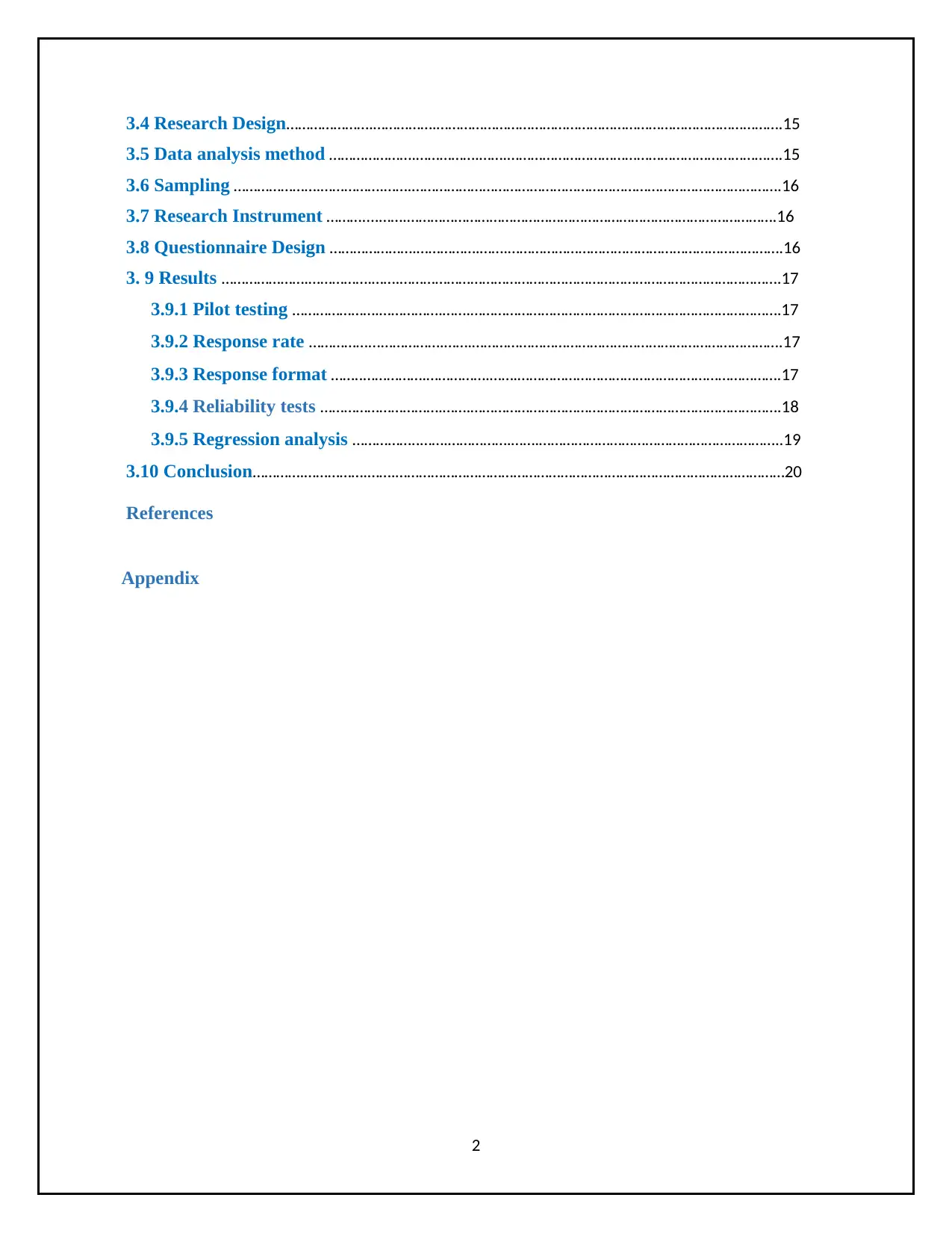
3.4 Research Design………………….…………….…………………………………………………………………………….15
3.5 Data analysis method ………………….…………….…….…………………………………………………………….15
3.6 Sampling ………………….…………….…….………………………………………………………………………………….16
3.7 Research Instrument ………....…….………………………………………………………………………………….16
3.8 Questionnaire Design ………………….…………….…….…………………………………………………………….16
3. 9 Results ………………….…………….…….…………………………………………………………………………………….17
3.9.1 Pilot testing ………………….…………….…….…………………………………………………………………….17
3.9.2 Response rate ……………...…………….…….…………………………………………………………………….17
3.9.3 Response format ……..…………….…………….…….………………………………………………………….17
3.9.4 Reliability tests ………………………….…….…………………………………………………………………….18
3.9.5 Regression analysis ……………..…….…………….…….……………………………………………………..19
3.10 Conclusion………….…………….…….………………………………………………………………………………………20
References
Appendix
2
3.5 Data analysis method ………………….…………….…….…………………………………………………………….15
3.6 Sampling ………………….…………….…….………………………………………………………………………………….16
3.7 Research Instrument ………....…….………………………………………………………………………………….16
3.8 Questionnaire Design ………………….…………….…….…………………………………………………………….16
3. 9 Results ………………….…………….…….…………………………………………………………………………………….17
3.9.1 Pilot testing ………………….…………….…….…………………………………………………………………….17
3.9.2 Response rate ……………...…………….…….…………………………………………………………………….17
3.9.3 Response format ……..…………….…………….…….………………………………………………………….17
3.9.4 Reliability tests ………………………….…….…………………………………………………………………….18
3.9.5 Regression analysis ……………..…….…………….…….……………………………………………………..19
3.10 Conclusion………….…………….…….………………………………………………………………………………………20
References
Appendix
2
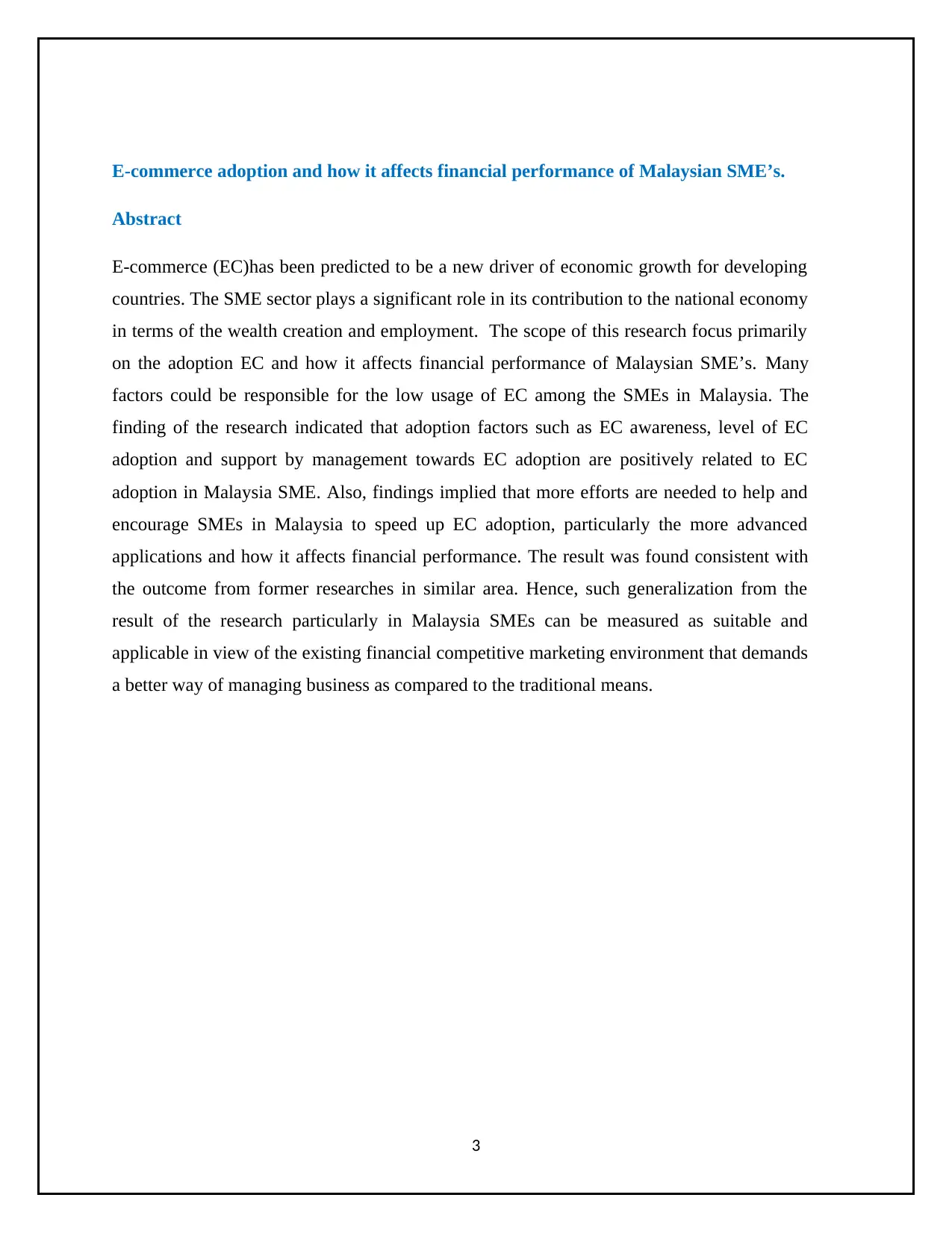
E-commerce adoption and how it affects financial performance of Malaysian SME’s.
Abstract
E-commerce (EC)has been predicted to be a new driver of economic growth for developing
countries. The SME sector plays a significant role in its contribution to the national economy
in terms of the wealth creation and employment. The scope of this research focus primarily
on the adoption EC and how it affects financial performance of Malaysian SME’s. Many
factors could be responsible for the low usage of EC among the SMEs in Malaysia. The
finding of the research indicated that adoption factors such as EC awareness, level of EC
adoption and support by management towards EC adoption are positively related to EC
adoption in Malaysia SME. Also, findings implied that more efforts are needed to help and
encourage SMEs in Malaysia to speed up EC adoption, particularly the more advanced
applications and how it affects financial performance. The result was found consistent with
the outcome from former researches in similar area. Hence, such generalization from the
result of the research particularly in Malaysia SMEs can be measured as suitable and
applicable in view of the existing financial competitive marketing environment that demands
a better way of managing business as compared to the traditional means.
3
Abstract
E-commerce (EC)has been predicted to be a new driver of economic growth for developing
countries. The SME sector plays a significant role in its contribution to the national economy
in terms of the wealth creation and employment. The scope of this research focus primarily
on the adoption EC and how it affects financial performance of Malaysian SME’s. Many
factors could be responsible for the low usage of EC among the SMEs in Malaysia. The
finding of the research indicated that adoption factors such as EC awareness, level of EC
adoption and support by management towards EC adoption are positively related to EC
adoption in Malaysia SME. Also, findings implied that more efforts are needed to help and
encourage SMEs in Malaysia to speed up EC adoption, particularly the more advanced
applications and how it affects financial performance. The result was found consistent with
the outcome from former researches in similar area. Hence, such generalization from the
result of the research particularly in Malaysia SMEs can be measured as suitable and
applicable in view of the existing financial competitive marketing environment that demands
a better way of managing business as compared to the traditional means.
3
⊘ This is a preview!⊘
Do you want full access?
Subscribe today to unlock all pages.

Trusted by 1+ million students worldwide
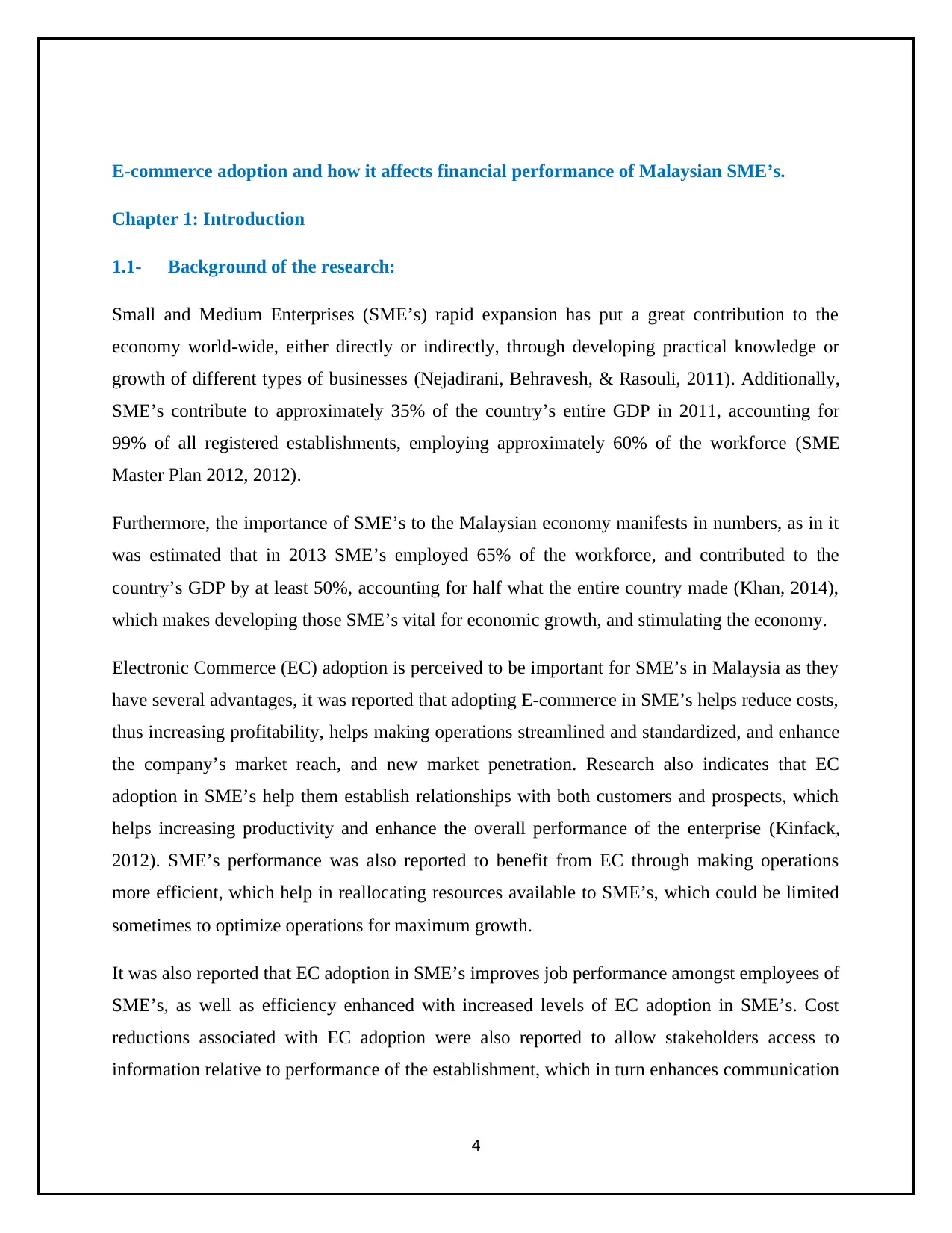
E-commerce adoption and how it affects financial performance of Malaysian SME’s.
Chapter 1: Introduction
1.1- Background of the research:
Small and Medium Enterprises (SME’s) rapid expansion has put a great contribution to the
economy world-wide, either directly or indirectly, through developing practical knowledge or
growth of different types of businesses (Nejadirani, Behravesh, & Rasouli, 2011). Additionally,
SME’s contribute to approximately 35% of the country’s entire GDP in 2011, accounting for
99% of all registered establishments, employing approximately 60% of the workforce (SME
Master Plan 2012, 2012).
Furthermore, the importance of SME’s to the Malaysian economy manifests in numbers, as in it
was estimated that in 2013 SME’s employed 65% of the workforce, and contributed to the
country’s GDP by at least 50%, accounting for half what the entire country made (Khan, 2014),
which makes developing those SME’s vital for economic growth, and stimulating the economy.
Electronic Commerce (EC) adoption is perceived to be important for SME’s in Malaysia as they
have several advantages, it was reported that adopting E-commerce in SME’s helps reduce costs,
thus increasing profitability, helps making operations streamlined and standardized, and enhance
the company’s market reach, and new market penetration. Research also indicates that EC
adoption in SME’s help them establish relationships with both customers and prospects, which
helps increasing productivity and enhance the overall performance of the enterprise (Kinfack,
2012). SME’s performance was also reported to benefit from EC through making operations
more efficient, which help in reallocating resources available to SME’s, which could be limited
sometimes to optimize operations for maximum growth.
It was also reported that EC adoption in SME’s improves job performance amongst employees of
SME’s, as well as efficiency enhanced with increased levels of EC adoption in SME’s. Cost
reductions associated with EC adoption were also reported to allow stakeholders access to
information relative to performance of the establishment, which in turn enhances communication
4
Chapter 1: Introduction
1.1- Background of the research:
Small and Medium Enterprises (SME’s) rapid expansion has put a great contribution to the
economy world-wide, either directly or indirectly, through developing practical knowledge or
growth of different types of businesses (Nejadirani, Behravesh, & Rasouli, 2011). Additionally,
SME’s contribute to approximately 35% of the country’s entire GDP in 2011, accounting for
99% of all registered establishments, employing approximately 60% of the workforce (SME
Master Plan 2012, 2012).
Furthermore, the importance of SME’s to the Malaysian economy manifests in numbers, as in it
was estimated that in 2013 SME’s employed 65% of the workforce, and contributed to the
country’s GDP by at least 50%, accounting for half what the entire country made (Khan, 2014),
which makes developing those SME’s vital for economic growth, and stimulating the economy.
Electronic Commerce (EC) adoption is perceived to be important for SME’s in Malaysia as they
have several advantages, it was reported that adopting E-commerce in SME’s helps reduce costs,
thus increasing profitability, helps making operations streamlined and standardized, and enhance
the company’s market reach, and new market penetration. Research also indicates that EC
adoption in SME’s help them establish relationships with both customers and prospects, which
helps increasing productivity and enhance the overall performance of the enterprise (Kinfack,
2012). SME’s performance was also reported to benefit from EC through making operations
more efficient, which help in reallocating resources available to SME’s, which could be limited
sometimes to optimize operations for maximum growth.
It was also reported that EC adoption in SME’s improves job performance amongst employees of
SME’s, as well as efficiency enhanced with increased levels of EC adoption in SME’s. Cost
reductions associated with EC adoption were also reported to allow stakeholders access to
information relative to performance of the establishment, which in turn enhances communication
4
Paraphrase This Document
Need a fresh take? Get an instant paraphrase of this document with our AI Paraphraser
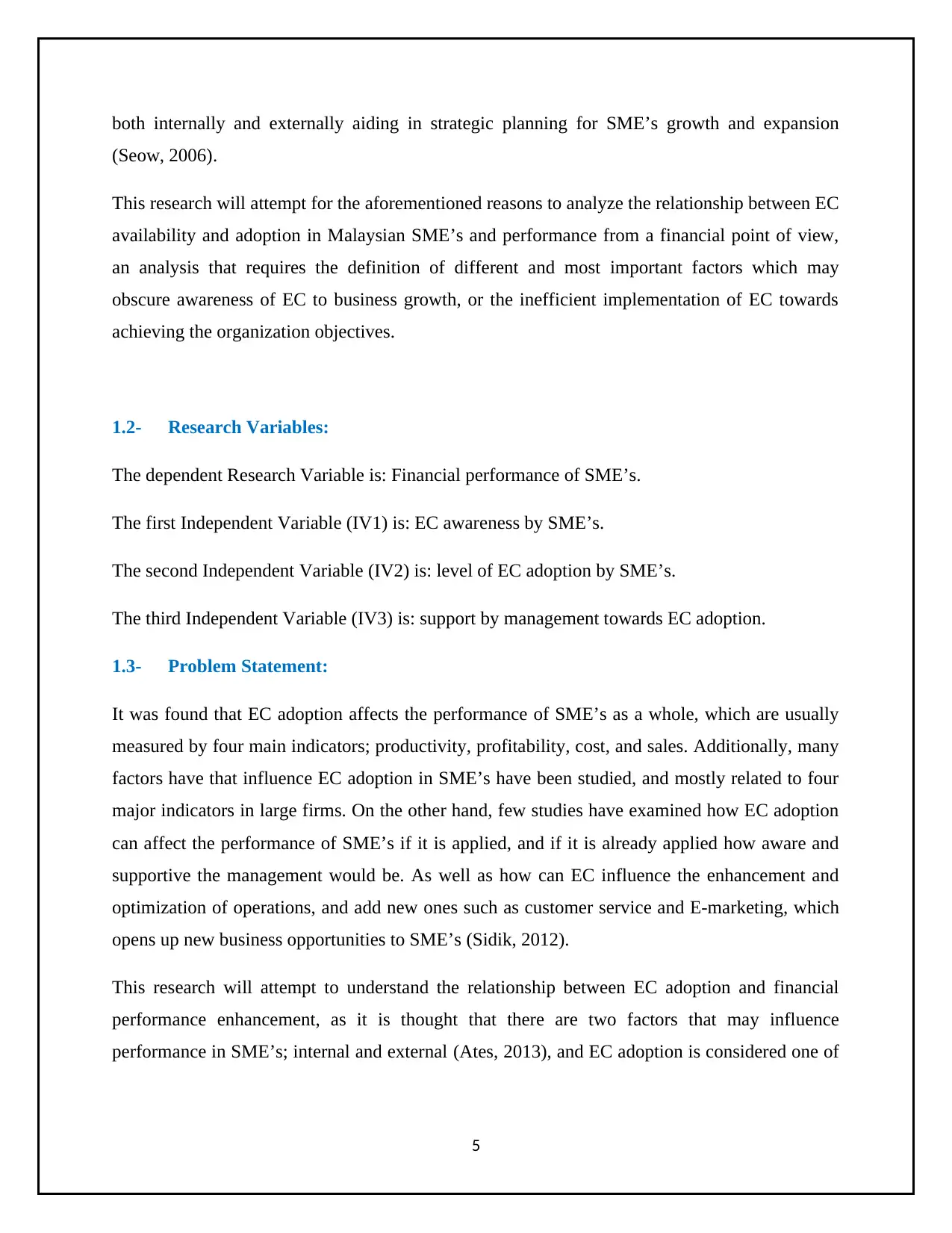
both internally and externally aiding in strategic planning for SME’s growth and expansion
(Seow, 2006).
This research will attempt for the aforementioned reasons to analyze the relationship between EC
availability and adoption in Malaysian SME’s and performance from a financial point of view,
an analysis that requires the definition of different and most important factors which may
obscure awareness of EC to business growth, or the inefficient implementation of EC towards
achieving the organization objectives.
1.2- Research Variables:
The dependent Research Variable is: Financial performance of SME’s.
The first Independent Variable (IV1) is: EC awareness by SME’s.
The second Independent Variable (IV2) is: level of EC adoption by SME’s.
The third Independent Variable (IV3) is: support by management towards EC adoption.
1.3- Problem Statement:
It was found that EC adoption affects the performance of SME’s as a whole, which are usually
measured by four main indicators; productivity, profitability, cost, and sales. Additionally, many
factors have that influence EC adoption in SME’s have been studied, and mostly related to four
major indicators in large firms. On the other hand, few studies have examined how EC adoption
can affect the performance of SME’s if it is applied, and if it is already applied how aware and
supportive the management would be. As well as how can EC influence the enhancement and
optimization of operations, and add new ones such as customer service and E-marketing, which
opens up new business opportunities to SME’s (Sidik, 2012).
This research will attempt to understand the relationship between EC adoption and financial
performance enhancement, as it is thought that there are two factors that may influence
performance in SME’s; internal and external (Ates, 2013), and EC adoption is considered one of
5
(Seow, 2006).
This research will attempt for the aforementioned reasons to analyze the relationship between EC
availability and adoption in Malaysian SME’s and performance from a financial point of view,
an analysis that requires the definition of different and most important factors which may
obscure awareness of EC to business growth, or the inefficient implementation of EC towards
achieving the organization objectives.
1.2- Research Variables:
The dependent Research Variable is: Financial performance of SME’s.
The first Independent Variable (IV1) is: EC awareness by SME’s.
The second Independent Variable (IV2) is: level of EC adoption by SME’s.
The third Independent Variable (IV3) is: support by management towards EC adoption.
1.3- Problem Statement:
It was found that EC adoption affects the performance of SME’s as a whole, which are usually
measured by four main indicators; productivity, profitability, cost, and sales. Additionally, many
factors have that influence EC adoption in SME’s have been studied, and mostly related to four
major indicators in large firms. On the other hand, few studies have examined how EC adoption
can affect the performance of SME’s if it is applied, and if it is already applied how aware and
supportive the management would be. As well as how can EC influence the enhancement and
optimization of operations, and add new ones such as customer service and E-marketing, which
opens up new business opportunities to SME’s (Sidik, 2012).
This research will attempt to understand the relationship between EC adoption and financial
performance enhancement, as it is thought that there are two factors that may influence
performance in SME’s; internal and external (Ates, 2013), and EC adoption is considered one of
5
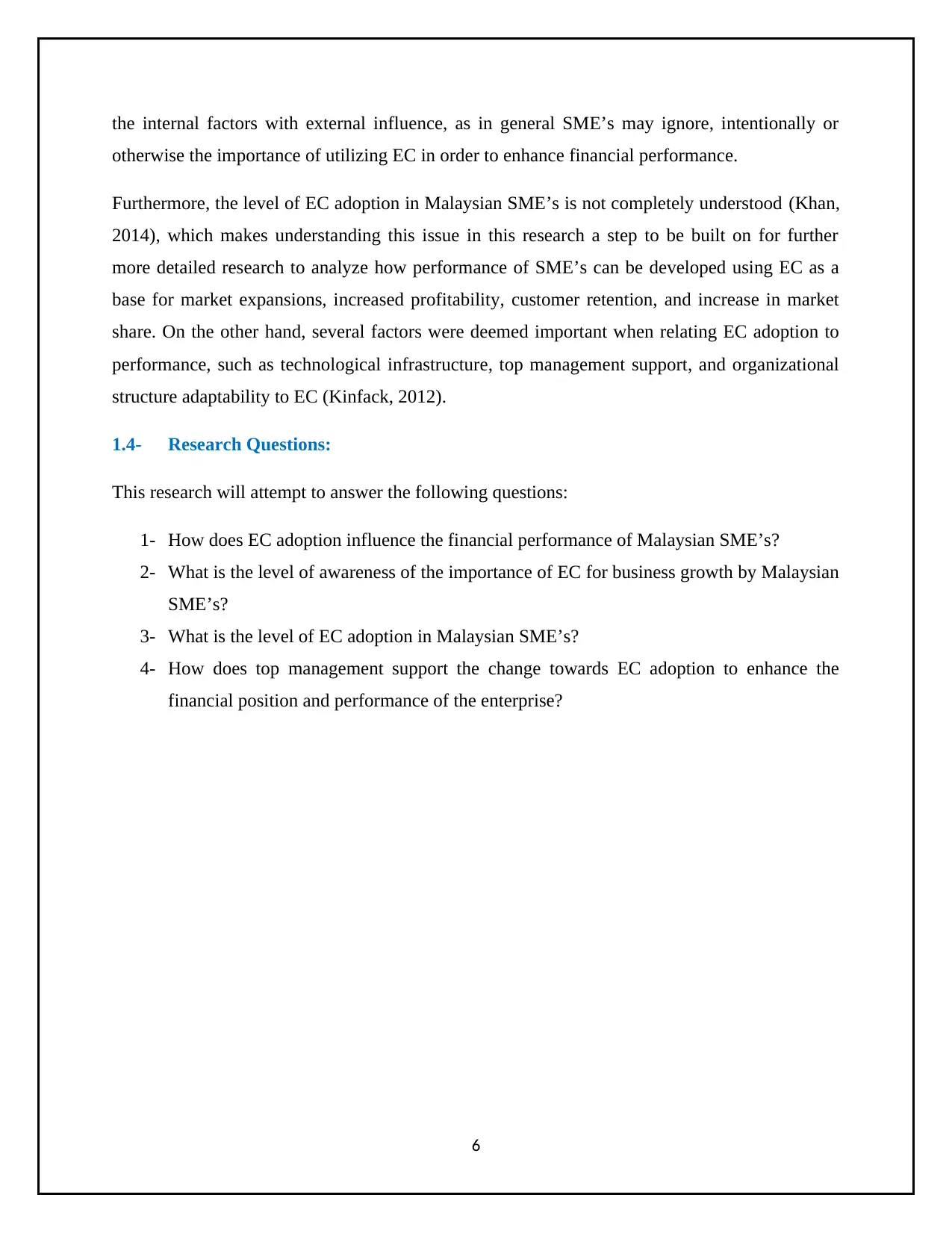
the internal factors with external influence, as in general SME’s may ignore, intentionally or
otherwise the importance of utilizing EC in order to enhance financial performance.
Furthermore, the level of EC adoption in Malaysian SME’s is not completely understood (Khan,
2014), which makes understanding this issue in this research a step to be built on for further
more detailed research to analyze how performance of SME’s can be developed using EC as a
base for market expansions, increased profitability, customer retention, and increase in market
share. On the other hand, several factors were deemed important when relating EC adoption to
performance, such as technological infrastructure, top management support, and organizational
structure adaptability to EC (Kinfack, 2012).
1.4- Research Questions:
This research will attempt to answer the following questions:
1- How does EC adoption influence the financial performance of Malaysian SME’s?
2- What is the level of awareness of the importance of EC for business growth by Malaysian
SME’s?
3- What is the level of EC adoption in Malaysian SME’s?
4- How does top management support the change towards EC adoption to enhance the
financial position and performance of the enterprise?
6
otherwise the importance of utilizing EC in order to enhance financial performance.
Furthermore, the level of EC adoption in Malaysian SME’s is not completely understood (Khan,
2014), which makes understanding this issue in this research a step to be built on for further
more detailed research to analyze how performance of SME’s can be developed using EC as a
base for market expansions, increased profitability, customer retention, and increase in market
share. On the other hand, several factors were deemed important when relating EC adoption to
performance, such as technological infrastructure, top management support, and organizational
structure adaptability to EC (Kinfack, 2012).
1.4- Research Questions:
This research will attempt to answer the following questions:
1- How does EC adoption influence the financial performance of Malaysian SME’s?
2- What is the level of awareness of the importance of EC for business growth by Malaysian
SME’s?
3- What is the level of EC adoption in Malaysian SME’s?
4- How does top management support the change towards EC adoption to enhance the
financial position and performance of the enterprise?
6
⊘ This is a preview!⊘
Do you want full access?
Subscribe today to unlock all pages.

Trusted by 1+ million students worldwide

1.5- Research Objectives:
1- The first objective of the research is to research if EC adoption has an influence in
enhancing the financial performance and stability of SME’s in Malaysia.
2- The second objective is to attempt to come up with empirical evidence in regards to EC
awareness effect on performance, and how it can be further enhanced by top management
support.
3- The third objective of the research is to come up with recommendations for further
research on how to enhance performance of SME’s financially utilizing EC tools.
1.6- Significance of the research:
For most SME’s they cannot see the potential that lies in EC adoption and how it can
significantly enhance their financial position and performance, through many ways EC adoption
is mainly concerned with facilitating electronic tools and modern communication, such as the
internet, emails, intranet, and extranet in communication and transaction, whether B-2-B or B-2-
C, EC always reduces costs association normal operations, and increases profitability (Ates,
2013). Also, the great contribution of SME’s to the economy of Malaysia has become more
important in economic instability the world witnesses, whereas, SME’s contributed to more than
half of the entire GDP in 2013, and are anticipated to increase that contribution rate to aid in the
national economic growth (Khan, 2014).
Another importance of this research is that it will add to the body of literature existing on levels
of EC adoption and how it affects the financial performance of SME’s in Malaysia, a subject not
often researched, as this research will attempt to analyze the level of adoption through collecting
information from surveys and questionnaires to selected SME’s from different sectors in the
Malaysian economy to try and understand to what extent is it applied, in order to come up with
recommendations that can be built upon towards the establishment of flourishing economy lead
by contribution from SME’s utilizing the already existing infrastructure necessary for EC
adoption and its positive influence on business development and growth (Khan, 2014).
7
1- The first objective of the research is to research if EC adoption has an influence in
enhancing the financial performance and stability of SME’s in Malaysia.
2- The second objective is to attempt to come up with empirical evidence in regards to EC
awareness effect on performance, and how it can be further enhanced by top management
support.
3- The third objective of the research is to come up with recommendations for further
research on how to enhance performance of SME’s financially utilizing EC tools.
1.6- Significance of the research:
For most SME’s they cannot see the potential that lies in EC adoption and how it can
significantly enhance their financial position and performance, through many ways EC adoption
is mainly concerned with facilitating electronic tools and modern communication, such as the
internet, emails, intranet, and extranet in communication and transaction, whether B-2-B or B-2-
C, EC always reduces costs association normal operations, and increases profitability (Ates,
2013). Also, the great contribution of SME’s to the economy of Malaysia has become more
important in economic instability the world witnesses, whereas, SME’s contributed to more than
half of the entire GDP in 2013, and are anticipated to increase that contribution rate to aid in the
national economic growth (Khan, 2014).
Another importance of this research is that it will add to the body of literature existing on levels
of EC adoption and how it affects the financial performance of SME’s in Malaysia, a subject not
often researched, as this research will attempt to analyze the level of adoption through collecting
information from surveys and questionnaires to selected SME’s from different sectors in the
Malaysian economy to try and understand to what extent is it applied, in order to come up with
recommendations that can be built upon towards the establishment of flourishing economy lead
by contribution from SME’s utilizing the already existing infrastructure necessary for EC
adoption and its positive influence on business development and growth (Khan, 2014).
7
Paraphrase This Document
Need a fresh take? Get an instant paraphrase of this document with our AI Paraphraser
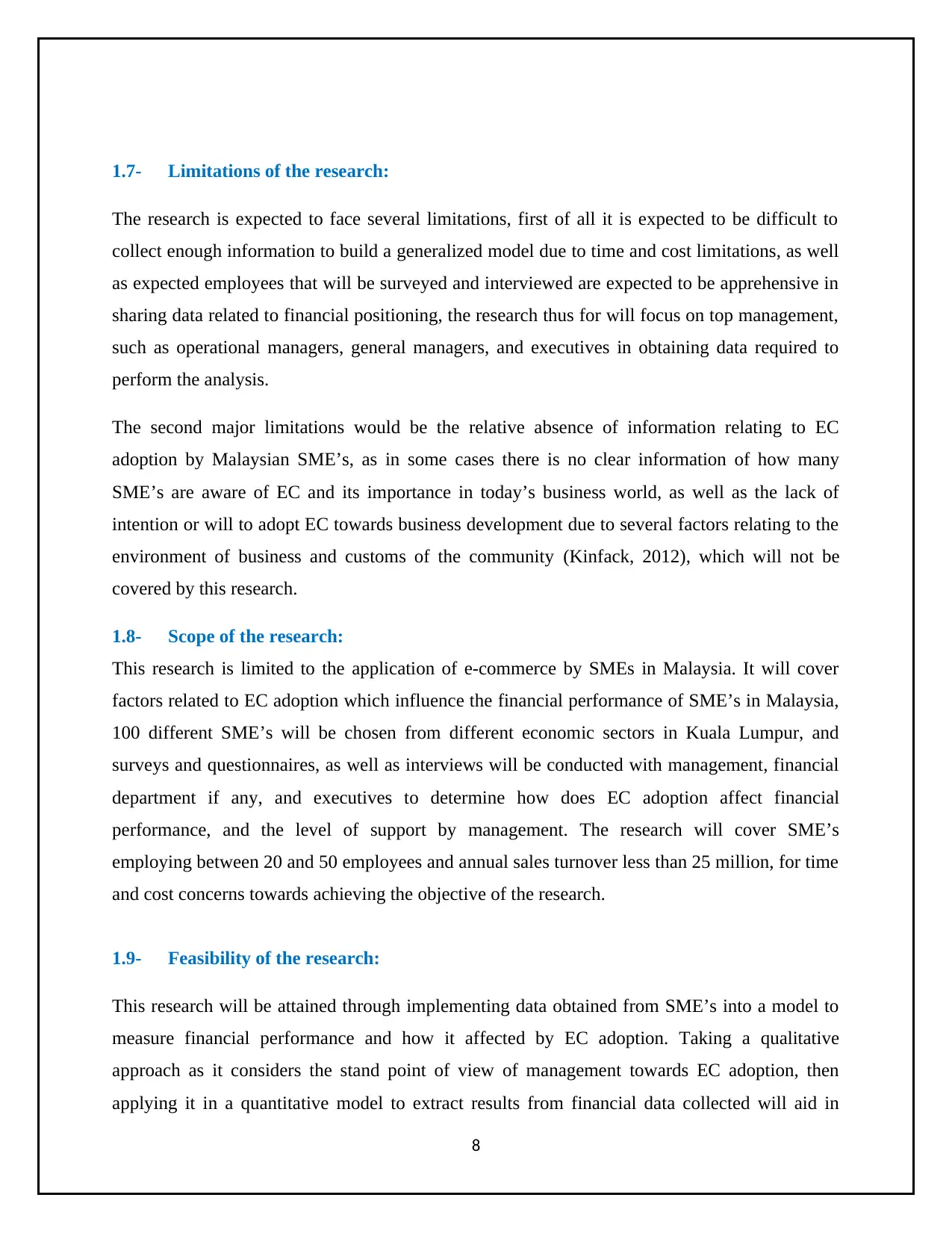
1.7- Limitations of the research:
The research is expected to face several limitations, first of all it is expected to be difficult to
collect enough information to build a generalized model due to time and cost limitations, as well
as expected employees that will be surveyed and interviewed are expected to be apprehensive in
sharing data related to financial positioning, the research thus for will focus on top management,
such as operational managers, general managers, and executives in obtaining data required to
perform the analysis.
The second major limitations would be the relative absence of information relating to EC
adoption by Malaysian SME’s, as in some cases there is no clear information of how many
SME’s are aware of EC and its importance in today’s business world, as well as the lack of
intention or will to adopt EC towards business development due to several factors relating to the
environment of business and customs of the community (Kinfack, 2012), which will not be
covered by this research.
1.8- Scope of the research:
This research is limited to the application of e-commerce by SMEs in Malaysia. It will cover
factors related to EC adoption which influence the financial performance of SME’s in Malaysia,
100 different SME’s will be chosen from different economic sectors in Kuala Lumpur, and
surveys and questionnaires, as well as interviews will be conducted with management, financial
department if any, and executives to determine how does EC adoption affect financial
performance, and the level of support by management. The research will cover SME’s
employing between 20 and 50 employees and annual sales turnover less than 25 million, for time
and cost concerns towards achieving the objective of the research.
1.9- Feasibility of the research:
This research will be attained through implementing data obtained from SME’s into a model to
measure financial performance and how it affected by EC adoption. Taking a qualitative
approach as it considers the stand point of view of management towards EC adoption, then
applying it in a quantitative model to extract results from financial data collected will aid in
8
The research is expected to face several limitations, first of all it is expected to be difficult to
collect enough information to build a generalized model due to time and cost limitations, as well
as expected employees that will be surveyed and interviewed are expected to be apprehensive in
sharing data related to financial positioning, the research thus for will focus on top management,
such as operational managers, general managers, and executives in obtaining data required to
perform the analysis.
The second major limitations would be the relative absence of information relating to EC
adoption by Malaysian SME’s, as in some cases there is no clear information of how many
SME’s are aware of EC and its importance in today’s business world, as well as the lack of
intention or will to adopt EC towards business development due to several factors relating to the
environment of business and customs of the community (Kinfack, 2012), which will not be
covered by this research.
1.8- Scope of the research:
This research is limited to the application of e-commerce by SMEs in Malaysia. It will cover
factors related to EC adoption which influence the financial performance of SME’s in Malaysia,
100 different SME’s will be chosen from different economic sectors in Kuala Lumpur, and
surveys and questionnaires, as well as interviews will be conducted with management, financial
department if any, and executives to determine how does EC adoption affect financial
performance, and the level of support by management. The research will cover SME’s
employing between 20 and 50 employees and annual sales turnover less than 25 million, for time
and cost concerns towards achieving the objective of the research.
1.9- Feasibility of the research:
This research will be attained through implementing data obtained from SME’s into a model to
measure financial performance and how it affected by EC adoption. Taking a qualitative
approach as it considers the stand point of view of management towards EC adoption, then
applying it in a quantitative model to extract results from financial data collected will aid in
8
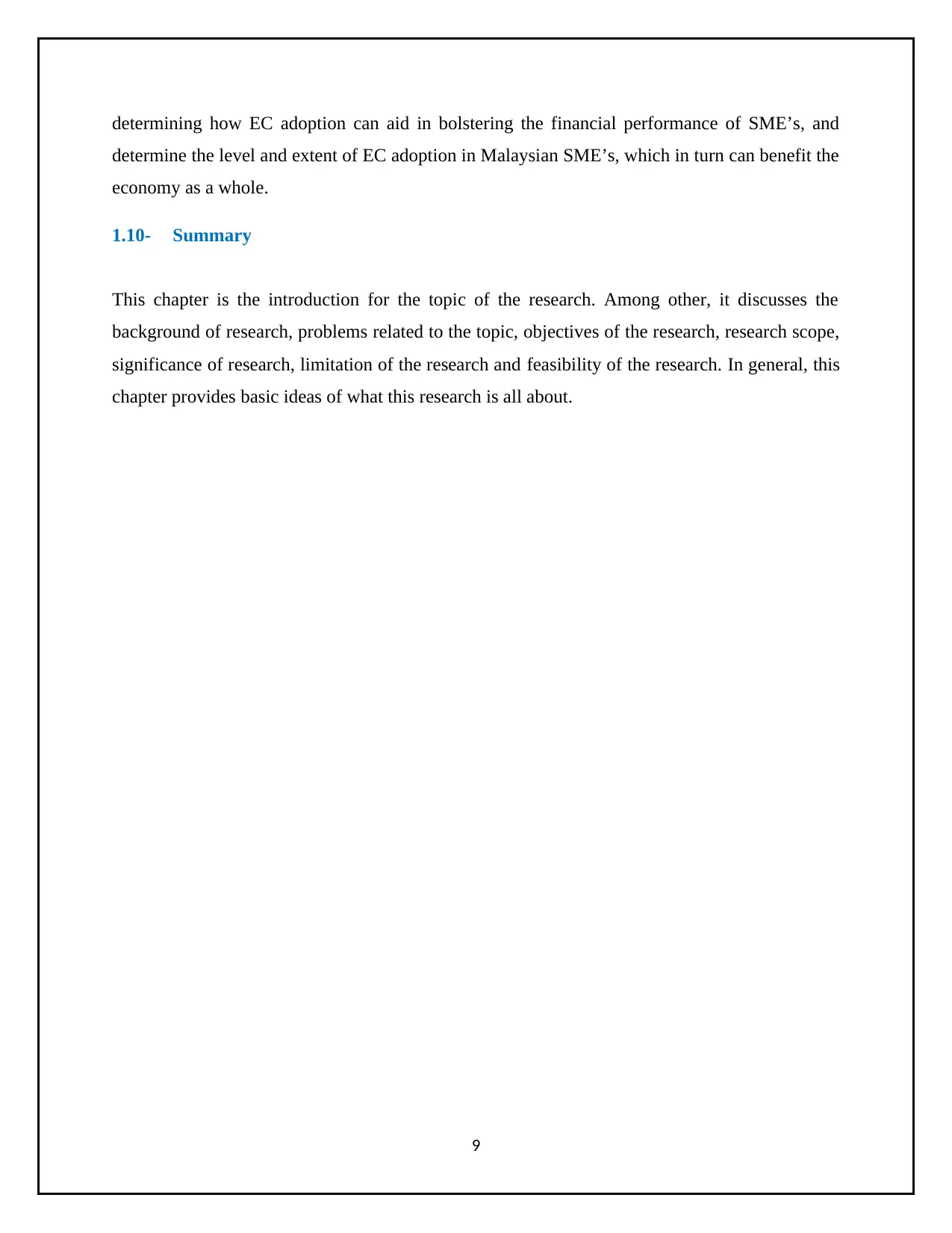
determining how EC adoption can aid in bolstering the financial performance of SME’s, and
determine the level and extent of EC adoption in Malaysian SME’s, which in turn can benefit the
economy as a whole.
1.10- Summary
This chapter is the introduction for the topic of the research. Among other, it discusses the
background of research, problems related to the topic, objectives of the research, research scope,
significance of research, limitation of the research and feasibility of the research. In general, this
chapter provides basic ideas of what this research is all about.
9
determine the level and extent of EC adoption in Malaysian SME’s, which in turn can benefit the
economy as a whole.
1.10- Summary
This chapter is the introduction for the topic of the research. Among other, it discusses the
background of research, problems related to the topic, objectives of the research, research scope,
significance of research, limitation of the research and feasibility of the research. In general, this
chapter provides basic ideas of what this research is all about.
9
⊘ This is a preview!⊘
Do you want full access?
Subscribe today to unlock all pages.

Trusted by 1+ million students worldwide
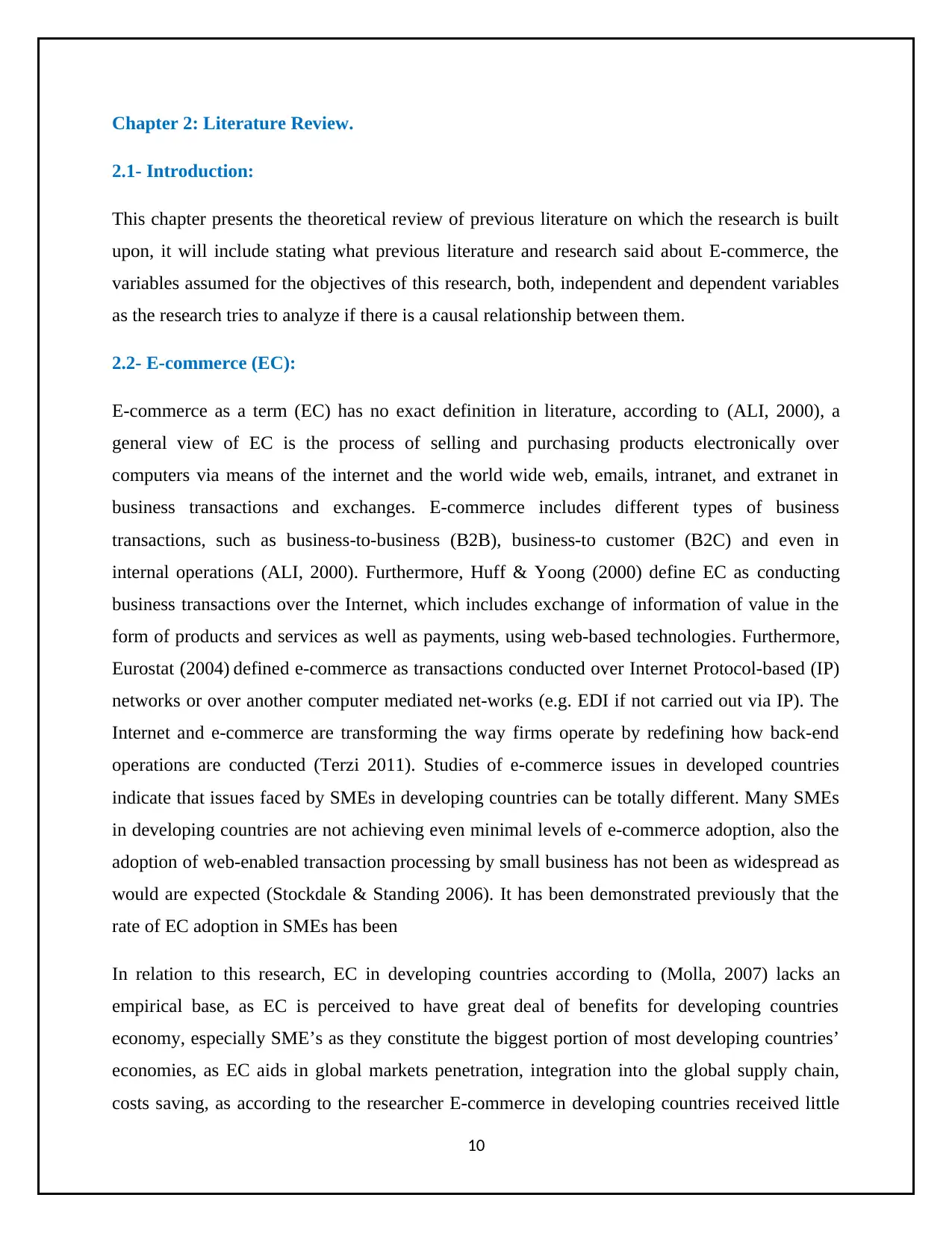
Chapter 2: Literature Review.
2.1- Introduction:
This chapter presents the theoretical review of previous literature on which the research is built
upon, it will include stating what previous literature and research said about E-commerce, the
variables assumed for the objectives of this research, both, independent and dependent variables
as the research tries to analyze if there is a causal relationship between them.
2.2- E-commerce (EC):
E-commerce as a term (EC) has no exact definition in literature, according to (ALI, 2000), a
general view of EC is the process of selling and purchasing products electronically over
computers via means of the internet and the world wide web, emails, intranet, and extranet in
business transactions and exchanges. E-commerce includes different types of business
transactions, such as business-to-business (B2B), business-to customer (B2C) and even in
internal operations (ALI, 2000). Furthermore, Huff & Yoong (2000) define EC as conducting
business transactions over the Internet, which includes exchange of information of value in the
form of products and services as well as payments, using web-based technologies. Furthermore,
Eurostat (2004) defined e-commerce as transactions conducted over Internet Protocol-based (IP)
networks or over another computer mediated net-works (e.g. EDI if not carried out via IP). The
Internet and e-commerce are transforming the way firms operate by redefining how back-end
operations are conducted (Terzi 2011). Studies of e-commerce issues in developed countries
indicate that issues faced by SMEs in developing countries can be totally different. Many SMEs
in developing countries are not achieving even minimal levels of e-commerce adoption, also the
adoption of web-enabled transaction processing by small business has not been as widespread as
would are expected (Stockdale & Standing 2006). It has been demonstrated previously that the
rate of EC adoption in SMEs has been
In relation to this research, EC in developing countries according to (Molla, 2007) lacks an
empirical base, as EC is perceived to have great deal of benefits for developing countries
economy, especially SME’s as they constitute the biggest portion of most developing countries’
economies, as EC aids in global markets penetration, integration into the global supply chain,
costs saving, as according to the researcher E-commerce in developing countries received little
10
2.1- Introduction:
This chapter presents the theoretical review of previous literature on which the research is built
upon, it will include stating what previous literature and research said about E-commerce, the
variables assumed for the objectives of this research, both, independent and dependent variables
as the research tries to analyze if there is a causal relationship between them.
2.2- E-commerce (EC):
E-commerce as a term (EC) has no exact definition in literature, according to (ALI, 2000), a
general view of EC is the process of selling and purchasing products electronically over
computers via means of the internet and the world wide web, emails, intranet, and extranet in
business transactions and exchanges. E-commerce includes different types of business
transactions, such as business-to-business (B2B), business-to customer (B2C) and even in
internal operations (ALI, 2000). Furthermore, Huff & Yoong (2000) define EC as conducting
business transactions over the Internet, which includes exchange of information of value in the
form of products and services as well as payments, using web-based technologies. Furthermore,
Eurostat (2004) defined e-commerce as transactions conducted over Internet Protocol-based (IP)
networks or over another computer mediated net-works (e.g. EDI if not carried out via IP). The
Internet and e-commerce are transforming the way firms operate by redefining how back-end
operations are conducted (Terzi 2011). Studies of e-commerce issues in developed countries
indicate that issues faced by SMEs in developing countries can be totally different. Many SMEs
in developing countries are not achieving even minimal levels of e-commerce adoption, also the
adoption of web-enabled transaction processing by small business has not been as widespread as
would are expected (Stockdale & Standing 2006). It has been demonstrated previously that the
rate of EC adoption in SMEs has been
In relation to this research, EC in developing countries according to (Molla, 2007) lacks an
empirical base, as EC is perceived to have great deal of benefits for developing countries
economy, especially SME’s as they constitute the biggest portion of most developing countries’
economies, as EC aids in global markets penetration, integration into the global supply chain,
costs saving, as according to the researcher E-commerce in developing countries received little
10
Paraphrase This Document
Need a fresh take? Get an instant paraphrase of this document with our AI Paraphraser
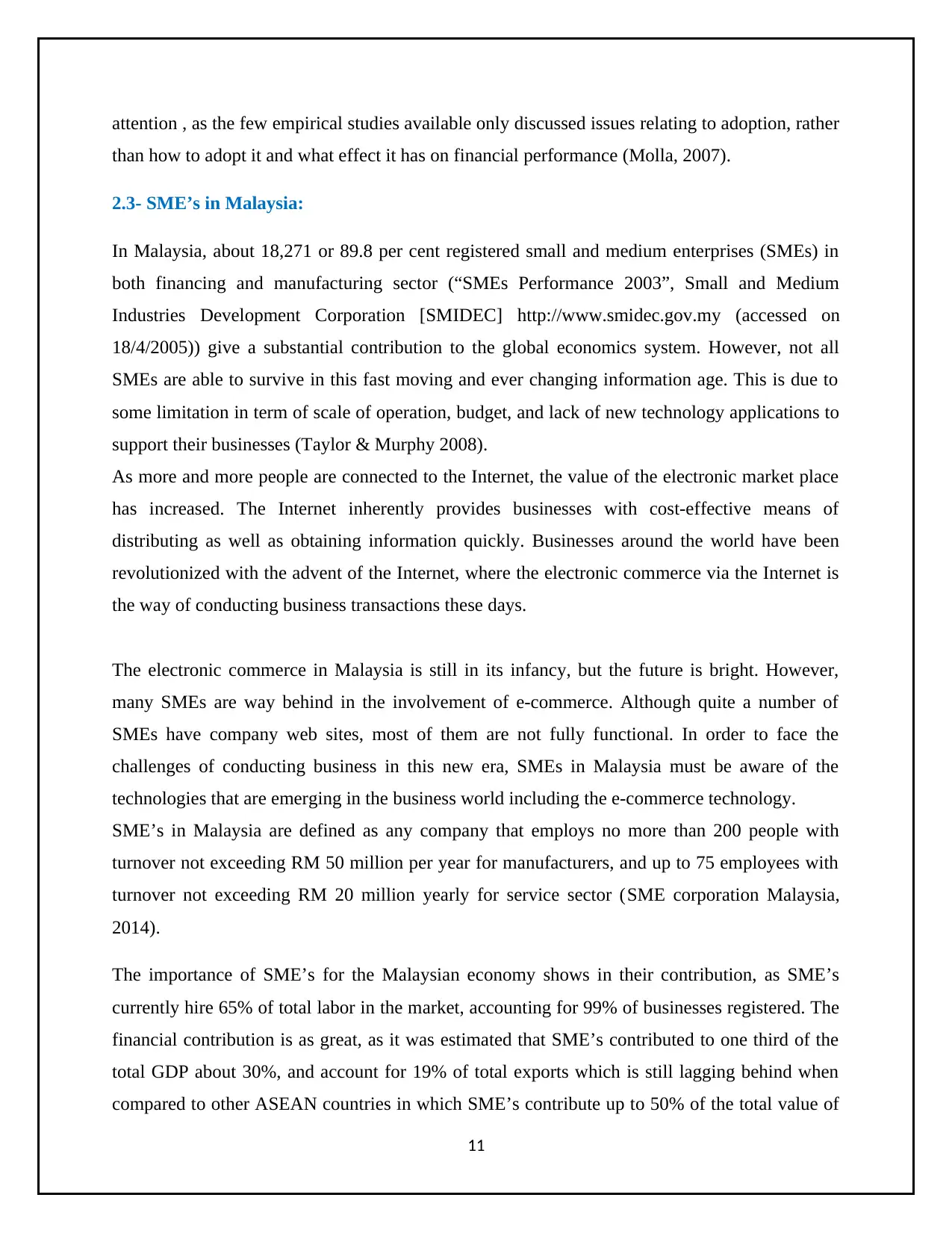
attention , as the few empirical studies available only discussed issues relating to adoption, rather
than how to adopt it and what effect it has on financial performance (Molla, 2007).
2.3- SME’s in Malaysia:
In Malaysia, about 18,271 or 89.8 per cent registered small and medium enterprises (SMEs) in
both financing and manufacturing sector (“SMEs Performance 2003”, Small and Medium
Industries Development Corporation [SMIDEC] http://www.smidec.gov.my (accessed on
18/4/2005)) give a substantial contribution to the global economics system. However, not all
SMEs are able to survive in this fast moving and ever changing information age. This is due to
some limitation in term of scale of operation, budget, and lack of new technology applications to
support their businesses (Taylor & Murphy 2008).
As more and more people are connected to the Internet, the value of the electronic market place
has increased. The Internet inherently provides businesses with cost-effective means of
distributing as well as obtaining information quickly. Businesses around the world have been
revolutionized with the advent of the Internet, where the electronic commerce via the Internet is
the way of conducting business transactions these days.
The electronic commerce in Malaysia is still in its infancy, but the future is bright. However,
many SMEs are way behind in the involvement of e-commerce. Although quite a number of
SMEs have company web sites, most of them are not fully functional. In order to face the
challenges of conducting business in this new era, SMEs in Malaysia must be aware of the
technologies that are emerging in the business world including the e-commerce technology.
SME’s in Malaysia are defined as any company that employs no more than 200 people with
turnover not exceeding RM 50 million per year for manufacturers, and up to 75 employees with
turnover not exceeding RM 20 million yearly for service sector (SME corporation Malaysia,
2014).
The importance of SME’s for the Malaysian economy shows in their contribution, as SME’s
currently hire 65% of total labor in the market, accounting for 99% of businesses registered. The
financial contribution is as great, as it was estimated that SME’s contributed to one third of the
total GDP about 30%, and account for 19% of total exports which is still lagging behind when
compared to other ASEAN countries in which SME’s contribute up to 50% of the total value of
11
than how to adopt it and what effect it has on financial performance (Molla, 2007).
2.3- SME’s in Malaysia:
In Malaysia, about 18,271 or 89.8 per cent registered small and medium enterprises (SMEs) in
both financing and manufacturing sector (“SMEs Performance 2003”, Small and Medium
Industries Development Corporation [SMIDEC] http://www.smidec.gov.my (accessed on
18/4/2005)) give a substantial contribution to the global economics system. However, not all
SMEs are able to survive in this fast moving and ever changing information age. This is due to
some limitation in term of scale of operation, budget, and lack of new technology applications to
support their businesses (Taylor & Murphy 2008).
As more and more people are connected to the Internet, the value of the electronic market place
has increased. The Internet inherently provides businesses with cost-effective means of
distributing as well as obtaining information quickly. Businesses around the world have been
revolutionized with the advent of the Internet, where the electronic commerce via the Internet is
the way of conducting business transactions these days.
The electronic commerce in Malaysia is still in its infancy, but the future is bright. However,
many SMEs are way behind in the involvement of e-commerce. Although quite a number of
SMEs have company web sites, most of them are not fully functional. In order to face the
challenges of conducting business in this new era, SMEs in Malaysia must be aware of the
technologies that are emerging in the business world including the e-commerce technology.
SME’s in Malaysia are defined as any company that employs no more than 200 people with
turnover not exceeding RM 50 million per year for manufacturers, and up to 75 employees with
turnover not exceeding RM 20 million yearly for service sector (SME corporation Malaysia,
2014).
The importance of SME’s for the Malaysian economy shows in their contribution, as SME’s
currently hire 65% of total labor in the market, accounting for 99% of businesses registered. The
financial contribution is as great, as it was estimated that SME’s contributed to one third of the
total GDP about 30%, and account for 19% of total exports which is still lagging behind when
compared to other ASEAN countries in which SME’s contribute up to 50% of the total value of
11
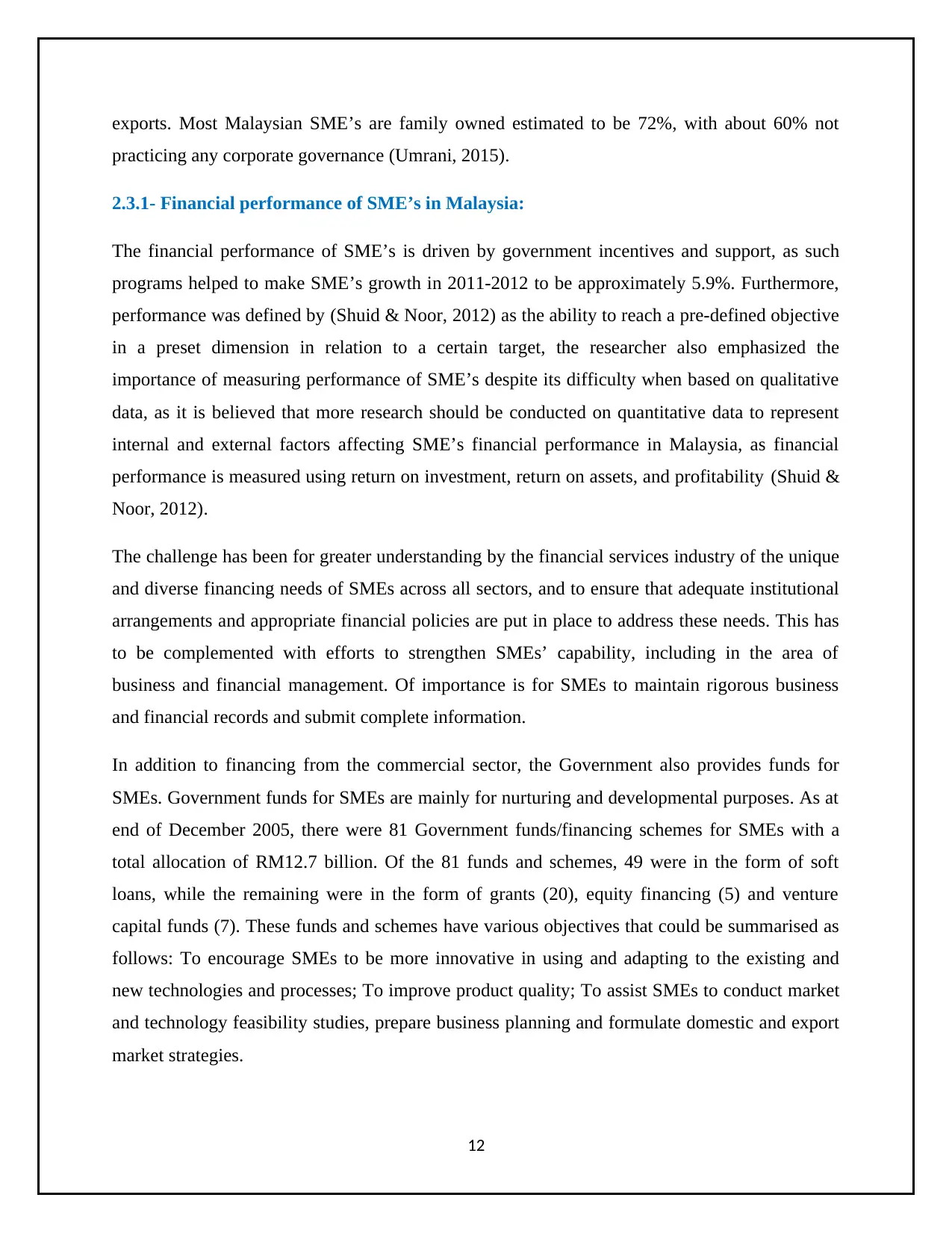
exports. Most Malaysian SME’s are family owned estimated to be 72%, with about 60% not
practicing any corporate governance (Umrani, 2015).
2.3.1- Financial performance of SME’s in Malaysia:
The financial performance of SME’s is driven by government incentives and support, as such
programs helped to make SME’s growth in 2011-2012 to be approximately 5.9%. Furthermore,
performance was defined by (Shuid & Noor, 2012) as the ability to reach a pre-defined objective
in a preset dimension in relation to a certain target, the researcher also emphasized the
importance of measuring performance of SME’s despite its difficulty when based on qualitative
data, as it is believed that more research should be conducted on quantitative data to represent
internal and external factors affecting SME’s financial performance in Malaysia, as financial
performance is measured using return on investment, return on assets, and profitability (Shuid &
Noor, 2012).
The challenge has been for greater understanding by the financial services industry of the unique
and diverse financing needs of SMEs across all sectors, and to ensure that adequate institutional
arrangements and appropriate financial policies are put in place to address these needs. This has
to be complemented with efforts to strengthen SMEs’ capability, including in the area of
business and financial management. Of importance is for SMEs to maintain rigorous business
and financial records and submit complete information.
In addition to financing from the commercial sector, the Government also provides funds for
SMEs. Government funds for SMEs are mainly for nurturing and developmental purposes. As at
end of December 2005, there were 81 Government funds/financing schemes for SMEs with a
total allocation of RM12.7 billion. Of the 81 funds and schemes, 49 were in the form of soft
loans, while the remaining were in the form of grants (20), equity financing (5) and venture
capital funds (7). These funds and schemes have various objectives that could be summarised as
follows: To encourage SMEs to be more innovative in using and adapting to the existing and
new technologies and processes; To improve product quality; To assist SMEs to conduct market
and technology feasibility studies, prepare business planning and formulate domestic and export
market strategies.
12
practicing any corporate governance (Umrani, 2015).
2.3.1- Financial performance of SME’s in Malaysia:
The financial performance of SME’s is driven by government incentives and support, as such
programs helped to make SME’s growth in 2011-2012 to be approximately 5.9%. Furthermore,
performance was defined by (Shuid & Noor, 2012) as the ability to reach a pre-defined objective
in a preset dimension in relation to a certain target, the researcher also emphasized the
importance of measuring performance of SME’s despite its difficulty when based on qualitative
data, as it is believed that more research should be conducted on quantitative data to represent
internal and external factors affecting SME’s financial performance in Malaysia, as financial
performance is measured using return on investment, return on assets, and profitability (Shuid &
Noor, 2012).
The challenge has been for greater understanding by the financial services industry of the unique
and diverse financing needs of SMEs across all sectors, and to ensure that adequate institutional
arrangements and appropriate financial policies are put in place to address these needs. This has
to be complemented with efforts to strengthen SMEs’ capability, including in the area of
business and financial management. Of importance is for SMEs to maintain rigorous business
and financial records and submit complete information.
In addition to financing from the commercial sector, the Government also provides funds for
SMEs. Government funds for SMEs are mainly for nurturing and developmental purposes. As at
end of December 2005, there were 81 Government funds/financing schemes for SMEs with a
total allocation of RM12.7 billion. Of the 81 funds and schemes, 49 were in the form of soft
loans, while the remaining were in the form of grants (20), equity financing (5) and venture
capital funds (7). These funds and schemes have various objectives that could be summarised as
follows: To encourage SMEs to be more innovative in using and adapting to the existing and
new technologies and processes; To improve product quality; To assist SMEs to conduct market
and technology feasibility studies, prepare business planning and formulate domestic and export
market strategies.
12
⊘ This is a preview!⊘
Do you want full access?
Subscribe today to unlock all pages.

Trusted by 1+ million students worldwide
1 out of 30
Related Documents
Your All-in-One AI-Powered Toolkit for Academic Success.
+13062052269
info@desklib.com
Available 24*7 on WhatsApp / Email
![[object Object]](/_next/static/media/star-bottom.7253800d.svg)
Unlock your academic potential
Copyright © 2020–2025 A2Z Services. All Rights Reserved. Developed and managed by ZUCOL.




